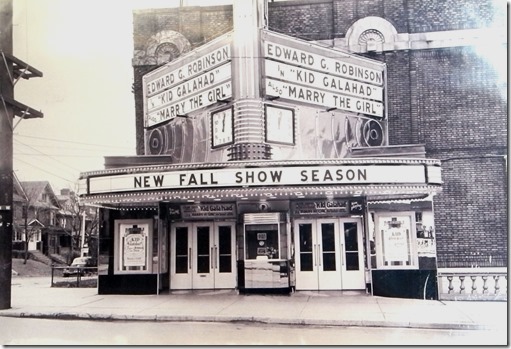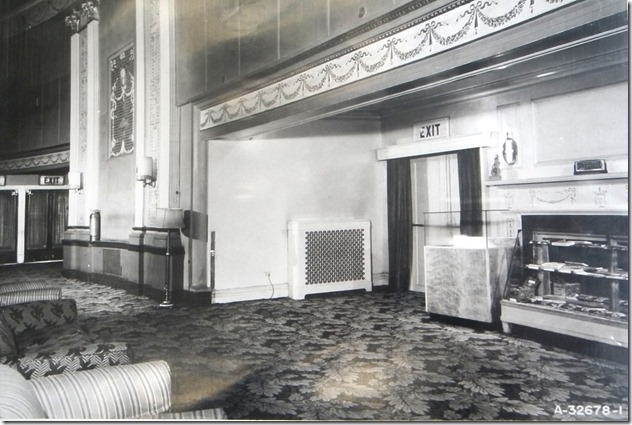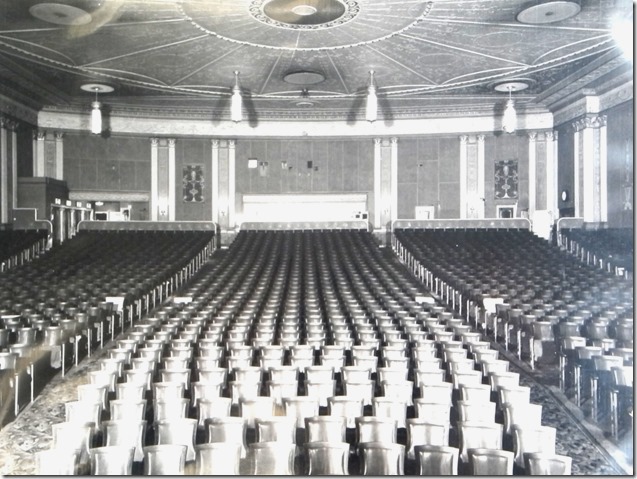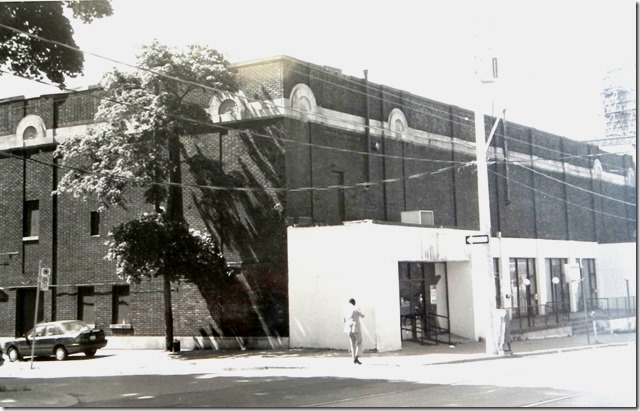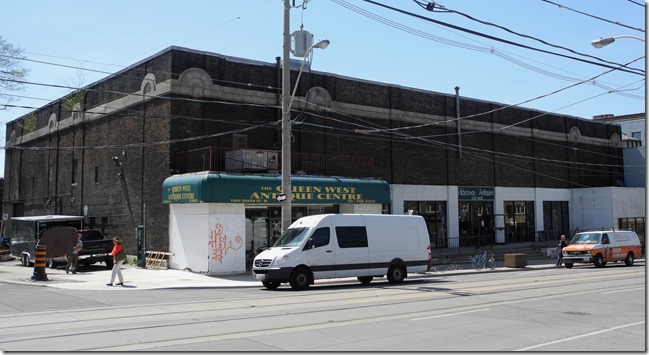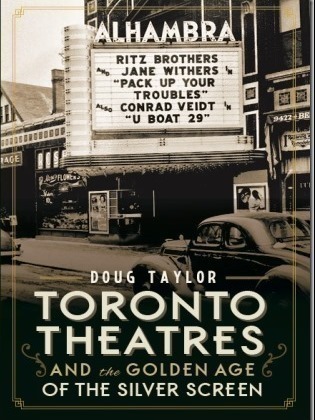The Parkdale Theatre in 1937. Photo City of Toronto Archives Series 1278, File 10130
The Parkdale Theatre at 1605 Queen Street West, on the northwest corner of Queen and Triller Avenue is another of Toronto’s theatres that I can readily recall, though I never was inside its doors. As a child, in the 1940s, I often gazed at its showy marquee from the windows of the Queen streetcars. On these occasions, we were on our way to Sunnyside Beach for a day beside the lake. The theatre was only one city block away from the “three-way corner” of Queen, Roncesvalles and King Street. We alighted from the streetcar at this intersection, crossed a narrow bridge spanning the railway tracks and descended the stairs to the amusement park and beach, located on Lakeshore Boulevard.
I also remember that at the three-way corner, on the northwest corner there was a Gray Coach Bus Terminal and next to it was the Edgewater Hotel. The Parkdale Theatre was only a short walk from these well-known city landmarks. All these building remain in existence today (2015), but have been converted for other commercial purposes.
The three-way corner (Queen, King and Roncesvalles) is to the left of the green arrow that indicates the location of the Parkdale Theatre.
In the late 19th century, Parkdale remained a relatively remote community to the west of the city, despite having been amalgamated with Toronto in 1889. On hot summer days, it was a favourite destination for Torontonians who wanted to swim in the cool waters of the lake. They visited the south end of Parkdale, where the beach area was known as Sunnyside.
However, in the first decade of the 20th century, as Toronto’s population crept westward, Parkdale’s population expanded. Prior to the First World War, construction commenced at Sunnyside to extend the beach and create an amusement park. The work ceased during the war and continued after it ended. As it neared completion, it was obvious that the area would be ideal for movie theatres. The opportunity was seized by the Allen brothers, Jule and Jay, who already owned the Allen Theatre (Tivoli) at Adelaide and Victoria Streets and the Allen’s Danforth.
The Parkdale opened on April 5, 1920, in time for the summer season. It was designed by Howard Crane of Detroit. The theatre was a large rectangular yellow-brick building, its auditorium built parallel to Queen Street. Its façade was relatively plain, except for stone detailing below the cornice. However, the interior of the Parkdale was luxurious, typical of most Allen theatres. Patrons were astonished at the gilded patterns and fancy plaster trim throughout the theatre. The ceiling was the equivalent of three storeys in height, containing well-crafted designs with enormous concentric rings with a large medallion in the centre. Striking decorative lines radiated from the central medallion. Chandeliers were suspended from this ornate ceiling, below it over 1500 seats with leather seats and backs. Four wide aisles allowed easy access and departures from the rows. The entrance lobby was equally as impressive, with Wedgewood-style designs above the entrance doors and those leading into the auditorium.
In January 1938, water-washed air conditioning was installed. It was not until 1950 that a candy bar was added. Today, this seems quite strange, as modern theatres derive a high percentage of their revenues from popcorn, drinks and other treats. Even stranger, after the candy bar was installed, the sale of popcorn was not allowed as it was considered too messy.
Despite its opulence, the Parkdale slowly lost in its competition with television. The theatre closed on July 6, 1970. The building on Queen Street in Parkdale remains today, but it has been converted into shops that specialize in second-hand and antique furniture.
Lobby of the Parkdale Theatre.
Auditorium of the Parkdale.
Parkdale Theatre after the building was converted to furniture shops.
The site of the Parkdale Theatre during the summer of 2014.
To view the Home Page for this blog: https://tayloronhistory.com/
To view previous blogs about movie houses of Toronto—historic and modern
Recent publication entitled “Toronto’s Theatres and the Golden Age of the Silver Screen,” by the author of this blog. The publication explores 50 of Toronto’s old theatres and contains over 80 archival photographs of the facades, marquees and interiors of the theatres. It relates anecdotes and stories of the author and others who experienced these grand old movie houses.
To place an order for this book:
Book also available in Chapter/Indigo, the Bell Lightbox Book Store and by phoning University of Toronto Press, Distribution: 416-667-7791
Theatres Included in the Book:
Chapter One – The Early Years—Nickelodeons and the First Theatres in Toronto
Theatorium (Red Mill) Theatre—Toronto’s First Movie Experience and First Permanent Movie Theatre, Auditorium (Avenue, PIckford), Colonial Theatre (the Bay), the Photodome, Revue Theatre, Picture Palace (Royal George), Big Nickel (National, Rio), Madison Theatre (Midtown, Capri, Eden, Bloor Cinema, Bloor Street Hot Docs), Theatre Without a Name (Pastime, Prince Edward, Fox)
Chapter Two – The Great Movie Palaces – The End of the Nickelodeons
Loew’s Yonge Street (Elgin/Winter Garden), Shea’s Hippodrome, The Allen (Tivoli), Pantages (Imperial, Imperial Six, Ed Mirvish), Loew’s Uptown
Chapter Three – Smaller Theatres in the pre-1920s and 1920s
Oakwood, Broadway, Carlton on Parliament Street, Victory on Yonge Street (Embassy, Astor, Showcase, Federal, New Yorker, Panasonic), Allan’s Danforth (Century, Titania, Music Hall), Parkdale, Alhambra (Baronet, Eve), St. Clair, Standard (Strand, Victory, Golden Harvest), Palace, Bedford (Park), Hudson (Mount Pleasant), Belsize (Crest, Regent), Runnymede
Chapter Four – Theatres During the 1930s, the Great Depression
Grant ,Hollywood, Oriole (Cinema, International Cinema), Eglinton, Casino, Radio City, Paramount, Scarboro, Paradise (Eve’s Paradise), State (Bloordale), Colony, Bellevue (Lux, Elektra, Lido), Kingsway, Pylon (Royal, Golden Princess), Metro
Chapter Five – Theatres in the 1940s – The Second World War and the Post-War Years
University, Odeon Fairlawn, Vaughan, Odeon Danforth, Glendale, Odeon Hyland, Nortown, Willow, Downtown, Odeon Carlton, Donlands, Biltmore, Odeon Humber, Town Cinema
Chapter Six – The 1950s Theatres
Savoy (Coronet), Westwood
Chapter Seven – Cineplex and Multi-screen Complexes
Cineplex Eaton Centre, Cineplex Odeon Varsity, Scotiabank Cineplex, Dundas Square Cineplex, The Bell Lightbox (TIFF)
